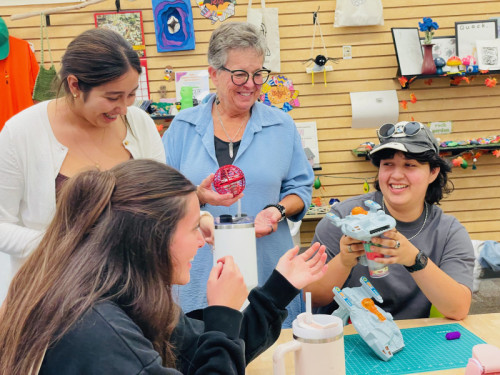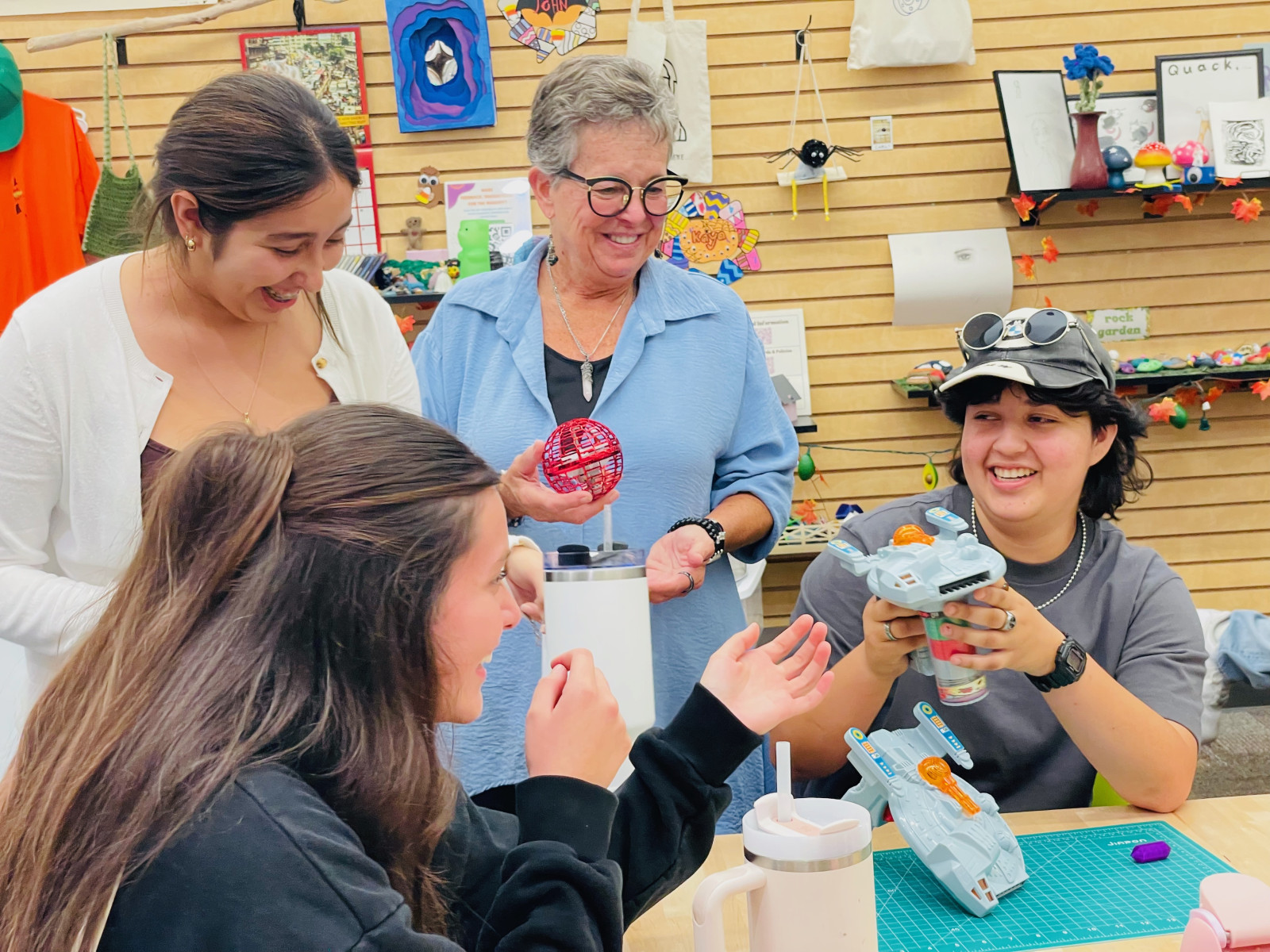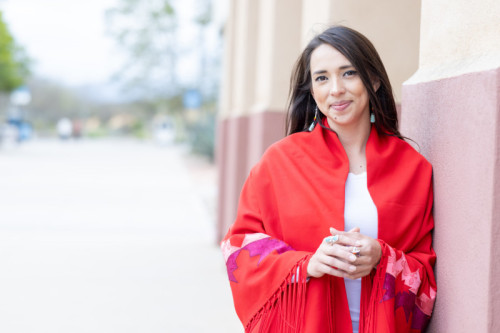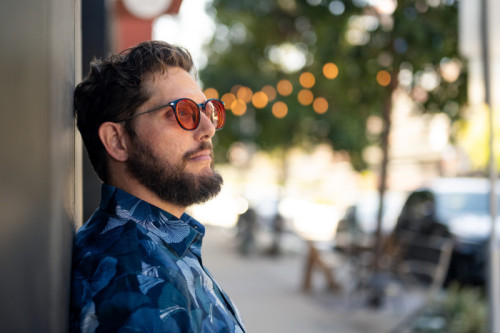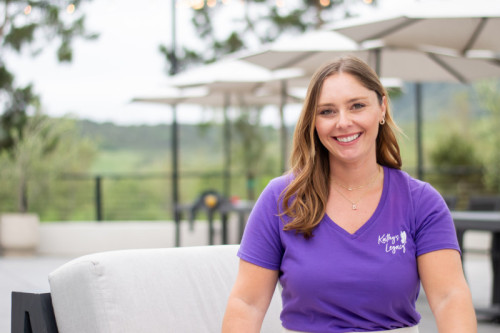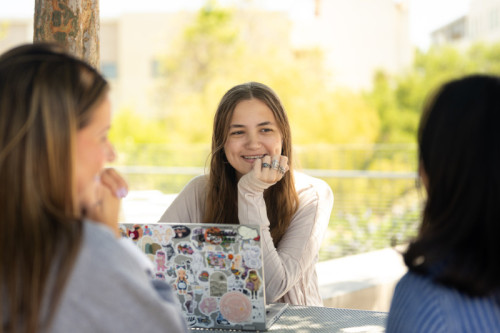Human Development Students Rediscover the Power of Play
28
October
2025
|
13:27 PM
America/Los_Angeles
By Marilyn Huerta
"; items += "
"; items += "
"; items += "
" + val['title'] + "
"; if(val['subtitle']){ items += "
" + val['subtitle'] + "
"; } items += "
"; if ((val['showpublishdate'] !== 0 && showPublishDateHeadlineSetting) || showPublishCityHeadlineSetting) { items += '
'; if (val['publishcity'] && showPublishCityHeadlineSetting) { items += '
' + val['publishcity'] + '
'; } if (val['showpublishdate'] !== 0 && showPublishDateHeadlineSetting) { items += "
"; items += "
" + date_month + "
"; items += "
" + date_day + "
,"; items += "
" + date_year + "
"; items += '
'; items += ' | '; items += '' + val['publish_time'] + ''; items += 'America/Los_Angeles'; items += '
'; items += '
'; } items += '
'; } items += "
" + val['message'] + "
"; items += "
Read more
"; items += "
"; items += ""; items += tags_items; items += multimedia_count; items += "
Latest News Release
- Alumna Finds Purpose in Advocacy for Native Children and FamiliesAs Maya Goodblanket reflects on her time as a student, she vividly remembers the day she found the California Indian Culture and Sovereignty Center at Cal State San Marcos. Goodblanket was nervous about checking out the CICSC. She didn’t know anyone on campus and was unsure about going inside. But she mustered the courage to open the door, and all of her anxiety disappeared as she was instantly welcomed. Little did she know that she was meeting mentors that day who would help her achieve the career she has today. Through intentional support from faculty and staff and inclusive spaces like the CICSC, CSUSM equips students to lead with identity, purpose and impact. “I was looking for that connection to my culture, and I found it on campus,” said Goodblanket, who received a bachelor’s degree in psychological science and a Master of Social Work at CSUSM. “I'm an out-of-state Native. My tribe is from Oklahoma, so I always am searching to reconnect with tribal communities and tribal culture.” Goodblanket, a member of the Cheyenne and Arapaho Tribes of Oklahoma, serves as an Indian Child Welfare Act (ICWA) court advocate for the Valley Center-based Indian Health Council, which provides health and wellness services for American Indian communities in north San Diego County. Any families involved in a child welfare case, such as a juvenile dependency proceeding, can rely on Goodblanket for support. "I work with moms and dads who are struggling with a variety of challenges," Goodblanket said. "One is substance abuse. My job is to support families in doing what they need to do to reunite with their kids if they’re not currently in a place to have them back. I also work with caregivers and family members who have taken placement of the children." Goodblanket’s cultural connection is at the heart of her advocacy. Under the ICWA, child welfare agencies must prioritize placing American Indian children with relatives or within their tribal communities whenever possible. “Natives are still removed at a disproportionate rate by child welfare services,” Goodblanket said. "When children are disconnected from their culture, their long-term outcomes aren't as strong as those who remain connected. That’s why the cultural component is such a vital part of the work I do." As a student, Goodblanket participated in CSUSM’s inaugural “Beyond the Stereotype" campaign to raise awareness about cultural appropriation and the harm caused by stereotypes. Goodblanket and other students were featured on posters across campus that challenged common misconceptions about underrepresented groups. She emphasized the need to raise awareness about issues like missing and murdered Indigenous women and the harmful sexualization of Native women through stereotypes and costumes, which contribute to broader societal perceptions and injustice. "Maya demonstrates how education driven by purpose and cultural knowledge creates lasting change,” said Joely Proudfit, chair of the American Indian studies department and director of the CICSC. “CSUSM remains grateful for her transformative impact, particularly through her leadership in the award-winning 'Beyond the Stereotype' campaign, where she challenged cultural appropriation with authenticity and understanding.” Goodblanket didn’t expect the campaign to have such a large impact, and its widespread presence across campus was surprising but meaningful. "I think it was really important to take that stance and just stand up,” she said. “And I think that's what college is all about.” Media Contact Eric Breier, Interim Assistant Director of Editorial and External Affairs ebreier@csusm.edu | Office: 760-750-7314
- After Surviving Battle With Hep C, Alumnus Now Helps Others Do SameRichard Jaenisch had received a death sentence at age 12. Diagnosed with hepatitis C, very unusual for a child that young, Jaenisch had been told by doctors that if he didn’t get a liver transplant, he wouldn’t live past 30. That disturbing prediction had hung over his adolescence and early adulthood like a black cloud, casting a pall over every doctor’s appointment and health episode. Now here it was, 2016, the year when Jaenisch turned 30, and the doctor’s assessment was feeling eerily prescient. He had not been able to procure a new liver, and his condition was deteriorating rapidly. To borrow his gallows humor, he was as “yellow as a Simpsons character” because of jaundice. He collectively spent more than six weeks in the hospital as a result of various complications from end-stage liver disease. “Every single day that year, I had a 30 to 60 percent chance of dying,” Jaenisch said. That he didn’t die, that he received a liver transplant on Dec. 3 (only a few months before his 31st birthday), Jaenisch considers to be nothing short of a miracle. Given the gift of fresh life in his fourth decade, he elected to devote it to ensuring that no one else has to go through the ordeal that he did. Three years later, Jaenisch returned to Cal State San Marcos – the university where he had earned a bachelor’s degree in social sciences in 2008 – to pursue a master’s in public health. He now works as the director of education and outreach for Open Biopharma Research and Training Institute, a Carlsbad nonprofit whose mission is to reduce the cost of pharmaceuticals like the ones that helped keep him alive while he waited for the miracle liver. More significantly, Jaenisch is a tireless patient advocate, dedicating countless hours to multiple organizations that share a goal of ending the scourge of hep C. He has transformed adversity into community impact, leveraging his CSUSM education to improve lives and strengthen public health across the state. “Richard is truly a special person,” said Carrie Frenette, the executive director of global medical affairs for Gilead Sciences and Jaenisch’s liver doctor for nine years starting in 2012. “I can’t think of anyone else who has so much expertise and understanding in their medical problems, advocates for themselves and then goes on to advocate for others. Honestly, it made it so easy to care for him, and it made it mean even more when he got his transplant and was healthy again.” 'I don’t know how you are still alive...’ It all started with brown pee. Jaenisch was a normal suburban kid growing up in Rancho Bernardo. When he was 12, his parents signed him up for a summer tennis camp. It was a sweltering day and he didn’t drink a lot of water; when he returned home and went to the bathroom, his urine was dark. His father took him to Rady Children’s Hospital, where he was put through a battery of tests on his kidneys, spleen and liver. The diagnosis of hepatitis C virus (HCV) stunned them, as did the subsequent wallop of bad news: After the rest of the family was tested, it was discovered that he contracted the infection at birth from his mother, who also was found to have HCV. Nothing, though, could have prepared Jaenisch for the haunting prognostication of liver transplant or death. “That shook me to my core,” he said. “My childhood was fundamentally changed. And my mom heard that, too, because she was in the room. It’s awkward hearing your own future from your child’s diagnosis. We shared a very odd relationship in that way.” At the time, in the late 1990s, there was no cure for HCV, only experimental treatments with low success rates and punishing side effects. Jaenisch’s mom started the drugs – interferon and ribavirin – almost immediately, but as a child, Jaenisch wasn’t eligible. The primary impact of HCV on his teenage years was that he was forced to cease participation in all sports and PE classes (because the disease can be transmitted through blood) and he began to suffer from a type of brain fog named hepatic encephalopathy (HE). After graduating from Rancho Bernardo High School, he attended Palomar College for two years, then transferred to CSUSM. There, he threw himself into classes in economics, history and political science – not only to satiate his hunger for knowledge but also to distract himself from the fear that constantly lingered at the back of his mind. “I wanted to live as much of my life as I could before everything hit the fan,” Jaenisch said. “Because I knew what was coming. When someone gives you a death sentence, you remember it, to say the least.” Jaenisch graduated from CSUSM in December 2008. Only a few weeks later, the trouble started. He attempted to begin the same treatment program his mom had undergone, but because of denials by his mom's employer, he wasn’t able to do so for about nine months. Once the snags finally had been resolved, the 12-week regimen of interferon and ribavirin didn’t work. He experienced all the negative effects of the drugs – in his case, painful inflammation and wild emotional swings – without any decrease in his body’s viral load. A second round at double the dosage early in 2010 similarly yielded no response. By this point, more than a decade after his HCV first had been discovered, Jaenisch had descended to the most serious stage on the scale that measures liver fibrosis, or scarring. F0 equates to no fibrosis, F1 is mild, F2 is moderate, and so on. He was at F4, which indicates the presence of cirrhosis, a condition in which the liver is extensively scarred and permanently damaged. Jaenisch had reached the dreaded end-stage liver disease, which essentially meant that the ticking of his clock was only accelerating. All the while, he was encountering roadblocks in his career. He had hoped to enter the niche field of traffic economics, but graduating into the Great Recession scuttled that plan. For a time, he held a job in tech support that he found unfulfilling. The work that did bring Jaenisch joy was for a group that offered before- and after-school services for elementary and middle schools in the Poway district of his youth. He envisioned a long-term future in that field but was stymied by both the ailing economy (which led to layoffs) and his illness (he claims he was a victim of disability discrimination but chose to spend his remaining time trying to get better rather than pursue a case.) While he tried to piece together enough work to retain his vital health insurance, Jaenisch’s health continued to deteriorate. In 2014, two years into her stint as his liver doctor, Frenette proffered a grim evaluation. “She said, ‘I don’t know how you are still alive with this liver,’ ” Jaenisch recalled. “She showed me pictures and was like, ‘Your liver is an old shoe. It is not doing what it’s supposed to do. But you’re still functioning.’ ” Every moment of optimism, it seemed, was followed by a stroke of misfortune. He began taking a new drug called Sovaldi (a direct-acting antiviral, or DAA) that was considered a game-changer for HCV patients in that it had an 86% cure rate in six months. Sure enough, Jaenisch’s viral load was approaching zero and his liver was curing. But then he contracted a C. diff bacterial infection (the suspect: spoiled food from a restaurant), which caused acute liver failure and brought his HVC roaring back. He later tried another second-generation DAA – Harvoni – that sounded promising but failed in the last week of treatment. As his liver continued to deteriorate, in 2016 he became too sick for treatment and, following a now-common hospitalization, an ER physician gave him outdated medical advice, which resulted in a case of sepsis that nearly killed him. End-stage liver disease is typically a rapid descent lasting as little as two years. For Jaenisch, it was an eight-year slog, from age 22 to 30. “He was in and out of the hospital multiple times, and he nearly didn’t make it to transplant multiple times,” Frenette said. “I can’t imagine anyone going through it with the courage and strength that he did.” Even after the liver transplant, Jaenisch wasn’t out of the woods. The operation addressed the issue of the failing liver, but it didn’t eradicate the HCV (the virus lives in the bloodstream). Frenette advised a treatment plan of Sovaldi, Zepatier and ribavirin, and that pharmaceutical concoction proved to be a magical formula. In September 2017, 18 years after the fateful diagnosis, Jaenisch was cured. “Honestly, I cried,” Frenette said. “He had been through so much, and to finally get rid of this awful virus that he had lived with his entire life and had caused his liver to fail … I don’t have words.” ‘I have to be more than a self-advocate' It was during one of his dozens of hospital stays that Jaenisch decided on the next course of his life, provided he would live long enough to choose. In the fall of 2014, he had been admitted to Sharp Memorial Hospital after the HCV returned via his C. diff infection. His medical team was struggling to lower his levels of bilirubin, a substance found in bile that was causing jaundice, the yellowing of the skin now so familiar to Jaenisch. He knew that ultraviolet rays help break down bilirubin, so he convinced the nurses to bring him outside for an hour a day at peak sun. As he had theorized, his bilirubin numbers declined. “It was at that point where I was like, ‘I have to be more than a self-advocate. If I can survive through transplant, I need to go to a Master of Public Health program,’ ” Jaenisch said. “I realized that that path would help me better understand how to become an advocate not only for myself but also for others.” His commitment would be nurtured in an environment like CSUSM, as he was accepted into its accelerated MPH program. His time back at the university overlapped with the pandemic, which he took advantage of by choosing as his thesis topic the emergency use authorization of COVID-19 tests. “He was very inquisitive and passionate,” said Asherlev Santos, an associate professor of public health and Jaenisch’s thesis adviser. “Sometimes that passion was more visible than the evidence of the inquiry, but all came from a place of helping others in some sort of need. He used his personal and professional experience to spur on what he did for his MPH degree.” His master’s allowed him to land his job at Open Biopharma, but it’s passion that mostly fuels Jaenisch in his advocacy connected to HCV. In 2016, while his body was still racked with the disease, he traveled to Sacramento with an organization known as CalHEP to talk to state legislators and raise awareness about viral hepatitis. The next year, when Congress was preparing to vote on a bill to repeal the Affordable Care Act, Jaenisch enlisted in the fight. He told his story of overcoming HCV in half a dozen TV interviews, worked at a call center, wrote letters – he did so much that the American Liver Foundation named him its liver champion of the year. “I wanted to preserve the things that help people get access to health care,” he said. “Because to me, it saved my life.” He also has volunteered for state and local groups such as End the Epidemics, the California Department of Public Health and the Eliminate Hepatitis C San Diego County Initiative. Their shared objective (in line with a goal established by the World Health Organization) is to eliminate hep C by 2030, which means a reduction of new infections by 90% and deaths by 65%. And the barriers are much lower than they used to be. Jaenisch says his family spent hundreds of thousands of dollars on treatment and other expenses to keep him alive. Today, treatment could run as cheap as a few hundred dollars, and that’s for more effective drugs, too. “I was raised in a middle-class suburban household, and I wouldn’t have known I had hep C if I didn’t pee a brown color,” Jaenisch said. “I’ve always maintained that I think we’re missing a lot of people, and I keep trying to push for us to find them and knock this virus out. We’re taking a lot of steps, and eventually we’ll get there.” Thanks to Jaenisch’s focus on access and innovation, those steps are becoming strides – toward a healthier, more equitable future for all. Media Contact Brian Hiro, Communications Specialist bhiro@csusm.edu | Office: 760-750-7306
- Attend Campus Webinar for Information on AB 481 Regulated Equipment ReportAs part of the university's commitment to transparency and open communication, the University Police Department (UPD) will host a webinar on Thursday, Oct. 30 at noon via Zoom (https://csusm.zoom.us/j/83186146403) . The Zoom meeting ID is 831 8614 6403. This webinar will provide information from the annual AB 481 Regulated Equipment report. Every year, agencies must report any military equipment used as part of their operations. This webinar is open to all CSUSM students, faculty and staff. No registration is required. For more about UPD policies, contact information and other campus services, visit www.csusm.edu/police.
- MBA Graduate Builds Meaningful Career Helping Domestic Violence SurvivorsAs co-executive director of Kathy’s Legacy Foundation, Alex Lutz will tell you that no two days are ever the same. One moment she’s assembling raffle baskets, the next she’s reviewing financial statements. “It’s almost like you could take a Fully Employed MBA class schedule and go, ‘OK, yep, you’ve tapped finance, you’ve tapped accounting, marketing, leadership,’ ” Lutz said. “Somehow, I have to wear one of those hats at any given point in my job.” Founded in the wake of a tragic act of domestic violence, Kathy’s Legacy Foundation honors the memory of Kathy Scharbarth, who was murdered by her ex-boyfriend in 2011. The nonprofit supports children and pets impacted by domestic violence – offering comfort, stability and hope through its two signature programs. Lutz, who joined the organization in 2019 after earning an MBA from Cal State San Marcos, thrives on the variety and challenges of nonprofit work. Her time at CSUSM helped her develop a deeper understanding of her strengths and areas for growth, while also fostering connections that continue to support her in her role today. “CSUSM helped me focus on what I felt like my strong suits were and what I liked and didn't like,” Lutz said. “The personal connections I made at CSUSM have become invaluable professional resources.” Years after graduating, Lutz came full circle when she collaborated with CSUSM business students on their Senior Experience project for Kathy’s Legacy. Although the project was ultimately cut short due to the pandemic, Lutz felt a strong connection to the students because she had completed similar projects while earning her MBA. “The project was marketing-focused, and we were working to try to reach donors who resonate with our mission, " Lutz said. “I was bummed that we didn't get to finish in person together, but I loved getting to work with them as someone who has gone through the same experience. It was great, and we got some amazing materials in return.” Lutz first connected with Kathy’s Legacy when a friend asked if she’d be interested in consulting on an event for the organization. She was immediately drawn to the mission and soon after was hired full time as a program manager. In the ensuing years, she steadily took on more responsibility, stepping into the role of co-executive director in 2024. “I feel like jumping in wholeheartedly and putting everything I had into Kathy’s Legacy led me to where I am today," Lutz said. The foundation’s work centers on two initiatives: the Silver Lining program, which helps children heal from the trauma of losing a parent to domestic violence, and the Lady’s Legacy program, which was inspired by Scharbarth’s yellow labrador, Lady, who was present when Scharbarth was killed. Lady became a symbol of the often-overlooked impact of domestic violence on pets. Lutz now helps coordinate multiple fundraising events throughout the year, including the annual Kathy’s Legacy Golf Tournament held at Twin Oaks Golf Course in San Marcos. The work isn’t easy, but Lutz says the impact is clear at the quarterly events Kathy’s Legacy hosts. There she sees firsthand how the organization is changing the lives of the children they support. “We had one boy who was not doing well during COVID and even long after the pandemic would wear a mask and have his hood up,” Lutz said. “But in the past year, the hood has come off and he’s smiling and engaging, which means something we’re doing is working. “I love that we can be that beacon of light and that reliability that these kids don't have anywhere else.” Media Contact Eric Breier, Interim Assistant Director of Editorial and External Affairs ebreier@csusm.edu | Office: 760-750-7314
- Chronic Illness a Journey of Strength, Self-Discovery ... and SaltThe first time I rode in an ambulance was in May 2024. I was in the middle of my 10:30 a.m. Communication 200 class when I realized my vision and hearing were failing. I couldn't keep my legs or arms straight and I couldn’t speak. The full memory is hazy, but I found myself sitting outside of Crash’s Market in the University Student Union with a handful of salt packets and on a Facetime call with my parents, who live in Tennessee. This experience didn’t come out of nowhere. I have postural orthostatic tachycardia syndrome, or POTS, a chronic condition that I’ve lived with since my junior year of high school. There’s not a lot known about POTS, but it's a disorder affecting the autonomic nervous system. When I switch positions (postural) – especially when I go from sitting to standing upright (orthostatic) – my heart rate rapidly increases. On average, it's over 100 beats per minute (tachycardia). POTS leaves me with a slew of symptoms. Daily, I experience dizziness, nausea, fatigue and brain fog, among others. Some people who have POTS faint frequently, even daily. I'm lucky enough that this doesn't typically happen to me, but I do experience presyncope, which means I go through all the symptoms of passing out while still fully conscious. When it occurs, I'm not able to see, speak or hear anything. I’m so dizzy I can’t walk straight. I get heat flashes. I remember only bits and pieces of what happens during these moments. The severity of my symptoms can vary, leading to an episode like the one I suffered in May 2024. If I have been walking or standing for too long, sitting for too long, am stressed out or if it’s hot outside, there’s a higher chance of an occurrence. That day in May, while I was on the phone and sitting outside of Crash’s Market, my parents called the paramedics. Determining that I couldn’t walk anywhere on my own and wouldn’t be able to for several hours, they took me by ambulance to the emergency room at a nearby hospital. Though it was my first time in an ambulance, I had made frequent visits to the ER over the previous four years. The process this time was the same as it had been for prior trips: They measured my vital signs, checked my heart with an electrocardiogram and did blood work to confirm POTS as the reason for the incident. Then I received an IV. IVs have been incredibly helpful. People with POTS struggle with low blood volume and tend to get fewer nutrients from the food we eat. An IV provides quick hydration and extra electrolytes. I also constantly consume extra salt, which helps improve blood volume. I add salt to my food, but in extreme cases, I will just eat plain salt packets. At restaurants, I always take an extra handful of salt packets from the condiment stand. These live in my purse or backpack, and I keep them handy in case I feel an episode coming. Some of my friends even carry salt packets when they’re hanging out with me. Despite the challenges, I try to focus on the positives. This journey has taught me to advocate for myself and surround myself with people who care about me, which is easy to do at Cal State San Marcos. Self-advocacy became a necessity as I went through many months of doctors’ appointments during high school trying to figure out what was wrong. Several doctors said everything I was going through was normal. But I knew it wasn’t. I wasn’t officially diagnosed with POTS until two years after my first symptoms. I had COVID twice during that time, and doctors believe that may have exposed an underlying condition. POTS is a chronic illness, meaning there is no cure. I’m a regular at the doctor’s office, with multiple appointments every month. Attending events causes heightened anxiety – both for me and the friends I’m with – and I do my best to be prepared in case of an episode. I had to take another ambulance ride in March. A friend and I were at a Kelsea Ballerini concert in San Diego. Though I had been fine the whole day, I started feeling nauseous and dizzy during the first opening act. I couldn’t stand. By the time Kelsea took the stage, the combination of the heat, crowd and strobe lights proved too much. My friend had to help hold me up as she guided me down the stairs to find the medics. Situations like this are frustrating. I don’t want to be a burden to friends and family, and I don’t want friends constantly worrying or family having to pick up slack. I’ve made some lifestyle changes in an attempt to lessen my symptoms. I take daily medication to ensure that my body keeps the right balance of salt and water. I drink tons of water with extra electrolytes and salt added. I try to walk every day to get my body more adjusted to moving. On hot days, I carry a mobile fan. And I also make sure to eat well. When I decided to attend CSUSM, the Disability Support Services office proved invaluable – they set me up with first-floor housing so I could avoid stairs (and anyone who has spent time on campus knows it’s no easy task to avoid stairs at CSUSM!). I also have learned to be more open about my condition. Through my on-campus job as a writing intern in the University Communications office, I’ve made great friends and found people who understand and support me. The experience has been an important part of pursuing my goal of becoming a writer. While CSUSM has helped me grow, my family and I made the difficult decision for me to move back to Tennessee at the end of the spring semester to focus on my health. I’ve had my share of challenges, but I also know how difficult it has been for my family to get calls in the middle of the night to learn I’ve been taken by ambulance to the ER when they’re 2,000 miles away. Though I’m heading east to finish college, I’ll always be thankful for my time at CSUSM – for the friends I’ve made, the support I’ve received and the confidence I’ve gained in sharing my story. Media Contact Eric Breier, Interim Assistant Director of Editorial and External Affairs ebreier@csusm.edu | Office: 760-750-7314
- Soccer Takes the Stage in 'The Wolves'The Cal State San Marcos theatre arts program will bring the complexities of teenage girlhood to the stage with “The Wolves.” The play, written by Pulitzer Prize finalist Sarah DeLappe, is a coming-of-age tale that follows a high school girls soccer team as players navigate degrees of adolescence, identity and growing up. Performances of “The Wolves” will take place in Arts 111 from Nov. 12-15 at 7 p.m. Tickets for students cost $10, while general admission tickets are $15. Through their interactions, rivalries and moments of vulnerability, the girls grapple with the nuances of teenage girlhood and the unspoken bonds that form within the team. Set entirely during pregame warmups, the performance captures the chaotic, overlapping conversations between players as they discuss everything from global politics to personal anxieties. To perfect the soccer moves in these moments, the actresses are being coached by Emily Mahmoud, a senior midfielder on the CSUSM women's soccer team. Media Contact Eric Breier, Interim assistant director of editorial and external affairs ebreier@csusm.edu | Office: 760-750-7314



